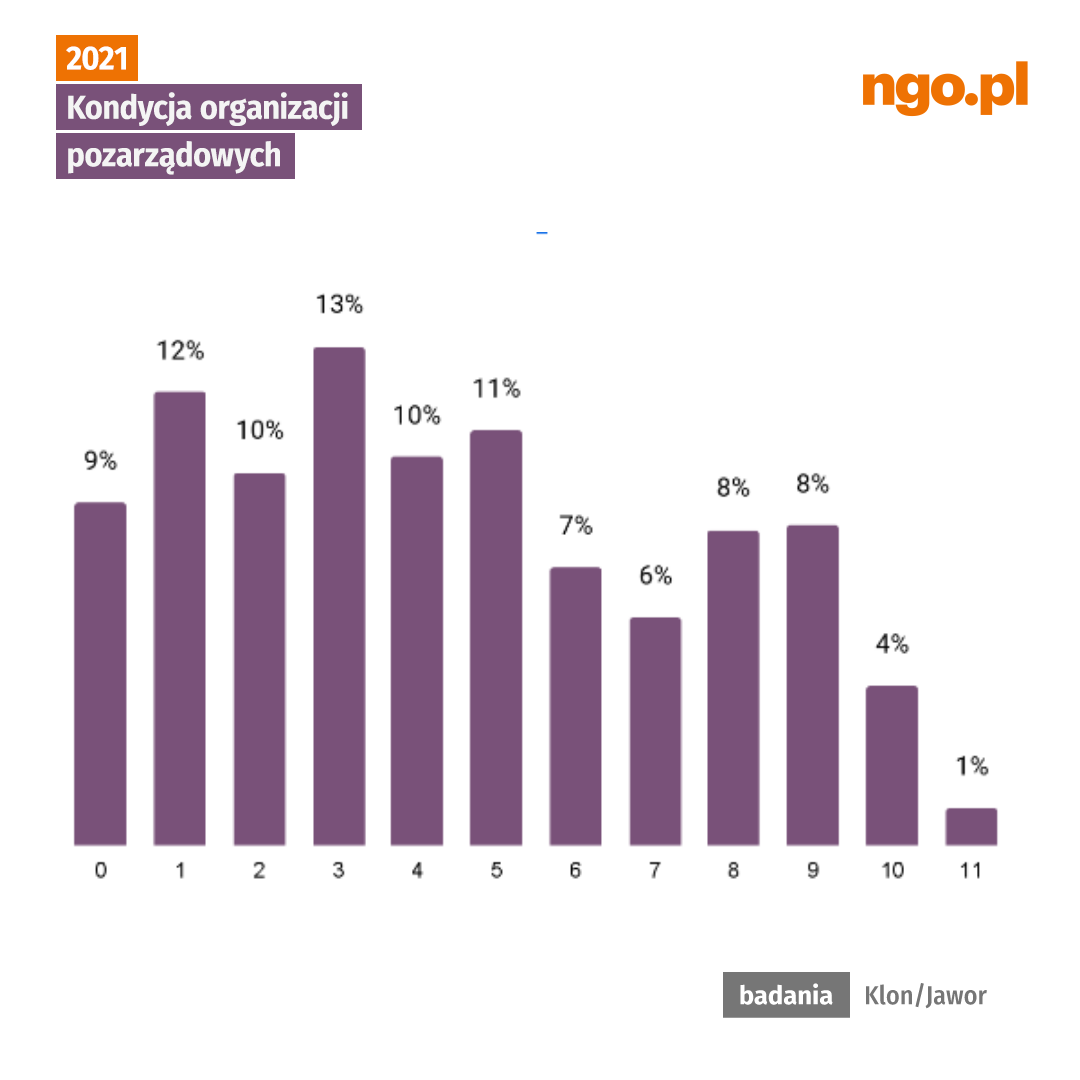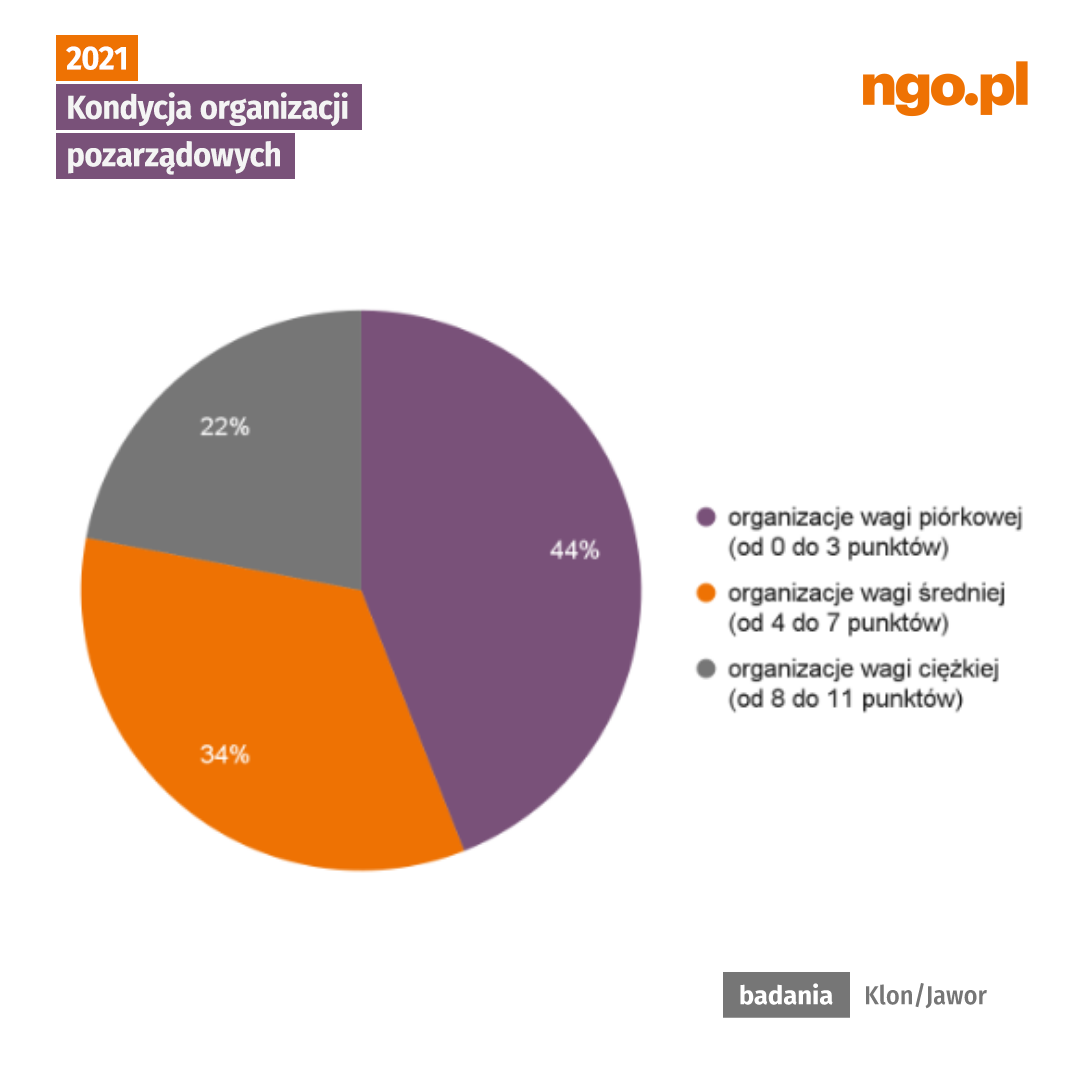Katalog kursów i poradników edu.ngo.pl na 2026 rok Zawsze pod ręką. Pobierz >
Under the magnifying glass. What are we like? The condition of the third sector. Featherweight, middleweight and heavyweight organizations
Data on the financial health of associations and foundations testify to the progressive stratification of NGOs as a result of the pandemic. To use a martial arts metaphor - the non-governmental sector is made up of "competitors in different weight classes".
In the article NGO Condition 2021: 5 facts about the financial condition of organizations, we presented the latest data on the financial resources of organizations. It paints a rather gloomy picture - compared to 2017, average revenues have fallen, and the share of organizations with financial reserves has also decreased. From the declarations of associations and foundations, it seems that a significant factor in the deterioration of their financial situation was the pandemic, the negative effects of which particularly affected organizations with fewer resources to begin with. Therefore, the key question now seems to be: will the pandemic accelerate and exacerbate the stratification of the sector.
Organizations wealth level index
To better understand the diversity of organizations in terms of financial and material resources on the basis of data from the "Condition of NGOs 2021" survey, we have created an Organization's Resources Index. In addition to the amount of revenue, it included data on sources of income, assets, equipment owned, hiring of employees, as well as subjective assessment of their own financial situation and self-reported state of the equipment.
Structure of the Organization's Resources Index
Indicators included in the Index:
a. amount of revenue in 2020
b. number of types of revenue sources
c. possession and size of financial reserves
d. using paid labor and having a permanent team of employees
e. owning/renting an office or premises
f. possession of at least one computer
g. subjective assessment of its own financial situation and the condition and level of equipment (self-reported)
2 Scale of ratings possible: 0 points (lowest level of resources) to 11 points (highest level of resources).
The Index intentionally omitted other resources that are important to the organization's functioning, such as active members and committed volunteers (indicative of the degree of social embedding), as well as the number of partners or network membership. We chose to focus on how organizations differentiate themselves by material and financial resources. Analyzing the types of organizations distinguished on the basis of the Index will allow us to see what other characteristics co-occur with differences in wealth.
Different weight classes
It becomes apparent at the first glance that the distribution of Organization's Resource Index score is "skewed" toward lower values. One in five organizations (21%) earned zero or one point (corresponding to the lowest level of resources), while at the other end of the scale, only 5% of associations and foundations earned eleven or ten points (corresponding to the greatest resources).
The prevalence of organizations with the fewest resources over those most wealthy ones can be seen even more clearly upon distinguishing three groups of associations and foundations based on their Index score. Sticking to the boxing metaphor, they can be grouped into: featherweight organizations (0 to 3 points), middleweight organizations (4 to 7 points) and heavyweight organizations (8 to 11 points). It turns out that organizations with the least abundant resources (featherweight) outnumber those with the most resources (heavyweight) by two-to-one.
What are the characteristics of the different groups of NGOs distinguished based on the Index score? As one might expect, differences in the amount of resources go hand in hand with other differences - both those related to the environment in which organizations operate and the way they operate.
Featherweight organizations (44% of the sector)
Featherweight organizations (44% of the sector)
- are more likely to be located in rural areas and small towns than the sector average, and less likely to feature in medium and large cities
- sports, arts and culture organizations feature more prominently
- average length of operation is 7 years
- half of these NGOs operate on a local scale (no larger than a county), while a proportion of those that operate on a national or international scale is below sector average
- in 2020, their average (median) revenues amounted to PLN 2 000
- more than ⅔ operate exclusively on a social basis (unpaid labor), while they are the least likely of all three groups of NGOs to work with volunteers
- half of them are active no more than once a week
- they associate less often - one in five belong to a federation or network
- are less likely to undertake outreach or fundraising activities, or create an action strategy
- the consequences of the pandemic have been most severe for them, which is perhaps why one in ten plans to significantly curb, suspend or terminate activities
- have a poor assessment of current operating conditions, but are relatively optimistic about the future
Middleweight organizations (34%)
- half are based in rural areas and small towns, the other half in medium and large cities
- are most often involved in sports, tourism, recreation and hobbies
- operate nationwide/internationally and locally in equal proportion (roughly 40% each)
- average length of operation is 9 years
- in 2020, average (median) income was PLN 44 000 in 2020
- one in three (32%) has a permanent paid team, with no one employed full-time
- ⅔ work and are available to the public every day or at least several days a week
- more than half want to keep their operations at the current level
Heavyweight organizations (22%)
- above-sector-average proportion of foundations
- ⅔ are based in medium and large cities
- more likely to operate in the fields of education, social welfare, health care
- almost half operate nationwide/internationally
- average length of operation is 16 years
- the pandemic was a trigger for development more often than for other NGO groups
- slightly more likely to work with volunteers
- in 2020, average (median) income was 378 000 PLN
- almost half have acquired EU funding at least once since their inception
- almost all have a permanent team, and 2/3 have full-time employees
- more often than others have a strategy, and undertake fundraising or outreach activities
- ¾ operate daily during business hours on weekdays
What are the consequences of the sector differences?
The proposed division of organizations serves to illustrate the problem of the sector's great division in terms of financial and material resources. However, it is worth noting that in other sectors such divisions are self-evident and sanctioned by law. Companies are divided by their size (and thus, in fact, their resources) into micro, small, medium and large companies. Could an analogous division also exist in the NGO sector?
In some legal areas, organizations are already treated differently depending on their size and resources. Alignment of reporting rules and the type of accounting to the size of the organization have been proposed in the draft law on reporting. However, it is still possible to identify areas where greater differentiation of duties and requirements depending on the size of the organization would be useful.
Bid competitions are a separate issue - the idea is not that smaller organizations or those from smaller towns should get preferential points, but that they should compete with organizations similar to themselves.
To once again use a martial arts metaphor - fighters representing the same weight categories should go into the ring, because only then is the fight fair.


